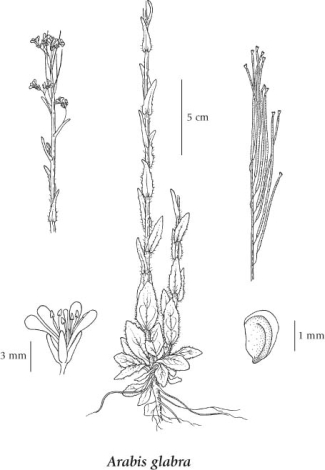Turritis glabra L.
tower mustard
Brassicaceae (Mustard family)
Introduction to Vascular Plants
tower mustard
Brassicaceae (Mustard family)
Introduction to Vascular Plants
Species Information
General:
Biennial or short-lived perennial herb from a simple stem-base; stems simple or branched above, 0.3-1.2 m tall, densely stiff-hairy at base, usually glabrous above.
Leaves:
Basal leaves oblanceolate, 3-14 cm long; stem leaves strongly overlapping, narrowly egg-shaped to lanceolate, 5-15 cm long, to 4 cm wide, unstalked and ear-like at the bases.
Flowers:
Many-flowered racemes; petals 5-6 mm long, cream sepals about 3 mm long, glabrous, not bulging at one side on the base.
Fruits:
siliques, erect, appressed to axis of the inflorescence, straight, glabrous, 6-10 cm long, 1-1.5 mm wide; seeds 1-1.5 mm wide, with very narrow wings.
Notes:
This taxon occurs in many native habitats but also readily colonizes roadsides and waste places. Its native status is therefore uncertain (Rollins 1993).
Illustration

If more than one illustration is available for a species (e.g., separate illustrations were provided for two subspecies) then links to the separate images will be provided below. Note that individual subspecies or varietal illustrations are not always available.
Illustration Source: The Illustrated Flora of British Columbia
Ecology
Ecological Framework for Turritis glabra
The table below shows the species-specific information calculated from
original data (BEC database) provided by the BC Ministry of Forests and Range.
(Updated August, 2013)
The table below shows the species-specific information calculated from
original data (BEC database) provided by the BC Ministry of Forests and Range.
(Updated August, 2013)
| Site Information |
Value / Class |
||
|
Avg |
Min |
Max |
|
| Elevation
(metres) |
929 | 38 | 2075 |
| Slope
Gradient (%) |
36 | 0 | 84 |
|
Aspect (degrees) |
190 | 23 | 358 |
| Soil
Moisture Regime (SMR) [0 - very xeric; 4 - mesic; 8 - hydric] |
2 | 0 | 5 |
| Modal
Nutrient Regime
Class |
C | ||
| #
of field plots species was recorded in: |
30 | ||
| Modal
BEC Zone Class |
ICH | ||
|
All BEC Zones (# of stations/zone) species was recorded in |
AT(2), CDF(7), CWH(1), ESSF(1), ICH(7), IDF(1), MS(4), PP(1), SBPS(2), SBS(2) | ||
|
Source:
Klinkenberg 2013
|
|||
Habitat and Range
Moist to dry streambanks, meadows, open forests, rock outcrops, roadsides and waste places in the lowland and montane zones; common throughout BC; E to PQ and S to GA and N CA; native status uncertain, also occurs in Eurasia.Status Information
Synonyms
Synonyms and Alternate Names:
Arabis glabra (L.) Bernh.